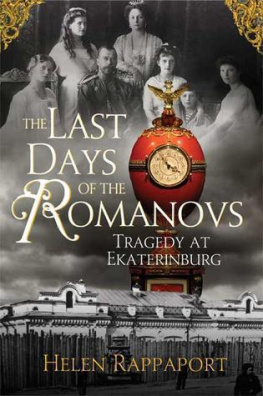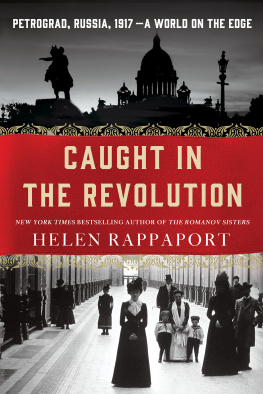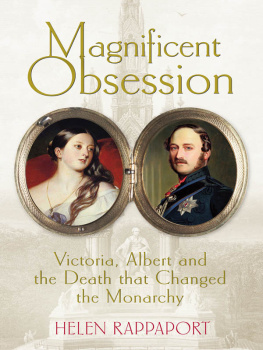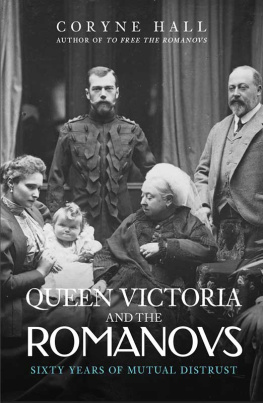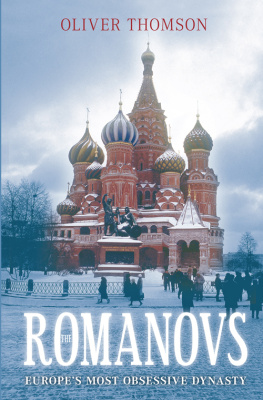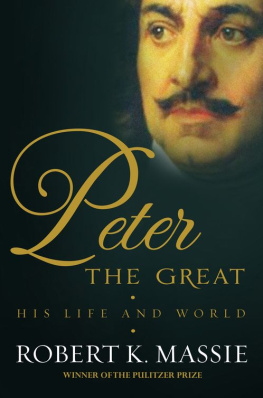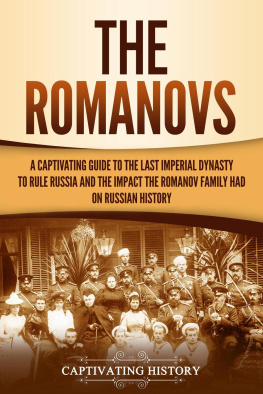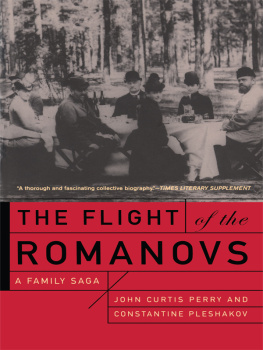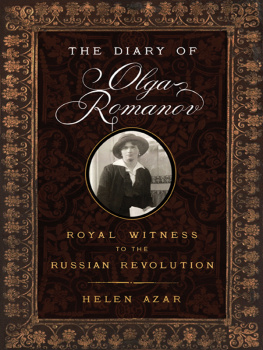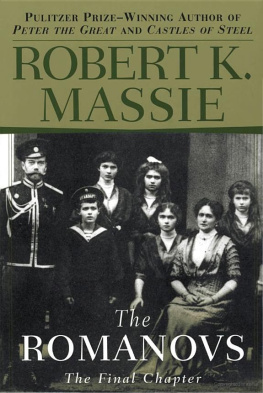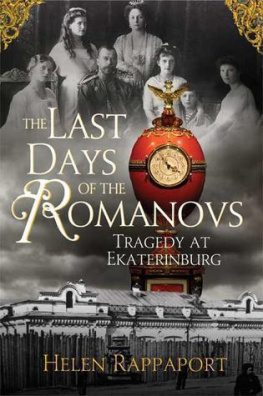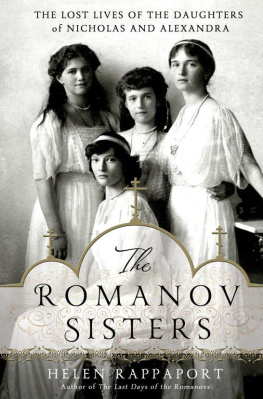THE LAST DAYS OF THE
ROMANOVS
ALSO BY HELEN RAPPAPORT
No Place for Ladies
Joseph Stalin
Queen Victoria
An Encyclopaedia of Women Social Reformers
Dark Hearts of Chicago
(with William Horwood)
THE LAST DAYS OF
THE ROMANOVS
TRAGEDY AT EKATERINBURG
Helen Rappaport
St. Martins Press
THE LAST DAYS OF THE ROMANOVS . Copyright 2008 by Helen Rappaport. All rights reserved. Printed in the United States of America. For information, address St. Martins Press, 175 Fifth Avenue, New York, N.Y. 10010.
www.stmartins.com
Library of Congress Cataloging-in-Publication Data Rappaport, Helen.
The last days of the Romanovs : tragedy at Ekaterinburg / Helen Rappaport.1st U.S. ed.
p. cm.
Includes bibliographical references and index.
ISBN-13: 978-0-312-37976-6
ISBN-10: 0-312-37976-5
1. Nicholas II, Emperor of Russia, 18681918Family. 2. Nicholas II, Emperor of Russia, 18681918Assassination. 3. EmperorsRussiaBiography. 4. RussiaHistoryNicholas II, 18941917.
DK258 .R35 2009
947.08'30922dc22
[B]
2008038733
First published in Great Britain as Ekaterinburg: The Last Days of the Romanovs by Hutchinson, an imprint of The Random House Group Limited First U.S. Edition: February 2009
10 9 8 7 6 5 4 3 2 1
For my daughters, Dani and Lucy
Contents
Acknowledgements
T he Ural Mountains are a very long way from home or so they seemed to me back in October 2006 when I began this project. I knew that I simply could not write the story of the Romanovs in Ekaterinburg without going to the city where it all happened. Despite my apprehensions, it proved to be a most wonderful, memorable experience; the one moment I shall never forget is standing among the thousands of worshippers at the all-night vigil held at the Church on the Blood to commemorate the murder of the Romanovs on the night of 1617 July. Here at last I got a sense of the power of the story and its continuing impact on Russian history and culture, and realised why Russia, its history and its people have always been and will remain a consuming passion in my life.
During my stay in Ekaterinburg there were several people without whose kindness and good company it might have been a lonely research trip. First and foremost, Alex Kilin of the History Faculty of the Urals State University proved an irrepressibly good companion and guide through two hot days in July walking the streets of Ekaterinburg from north to south and east to west. I am deeply grateful for his time, his energy and his lively discourse on the city, and for the fact that he spoke no English it made me work very hard at my Russian.
Valentina Lapina of the British Council offices at the Belinsky Library was kind and welcoming from my very first day and offered the use of internet and email, as well as providing endless cups of tea with her wonderful home-made jam, and inviting me out to her family dacha near Lake Baltysh. Valery Gafurov gave up time to meet and talk with me and drive me round the city. He also kindly set up my meetings with Professors Alekseev and Plotnikov. Professor Venyamin Alekseev found time in a very busy schedule as Vice-President of the Urals Branch of the Russian Academy of Sciences to talk to me about his long-standing research on the Romanov murders. Irina Bedrina of the Ural State Law Academy accompanied me across Ekaterinburg to visit Professor Ivan Plotnikov (about whose outstanding contribution to Romanov studies see Note on Sources). Despite being in frail health, Professor Plotnikov generously gave of his time to talk to me about his many fascinating theories. Konstantin Brylyakov of the Ekaterinburg Guide Centre arranged my trip to Ganina Yama with guide Nadezhda Sokolova, who provided a vivid non-stop Russian commentary on the Romanov story. Princess Svetlana Galitzine of Oxford, while visiting family in Ekaterinburg, kindly met up with me to talk about the city.
My thanks also must go to the many nameless worshippers I talked to at the Church on the Blood and the Voznesensky Cathedral in Ekaterinburg about the Romanovs and their Orthodox faith. A special word of thanks is due to Irina Chirkova, a volunteer at the Voznesensky Cathedral, who out of the goodness of her very warm Russian heart gave me her own treasured copy of Gleb Panfilovs film Romanovy Ventsenosnaya Semya (2000), which I had not been able to locate anywhere. Her gesture was typical of the warmth and kindness I met everywhere in Ekaterinburg, down to the delightful reception staff at the Park Inn who made my stay such a pleasure and were so complimentary about my Russian.
Back home in England I am hugely grateful to the specialist knowledge and help of Phil Tomaselli, an outstanding expert on British Secret Service and Russian-related Foreign Office and War Office records at Kew for the period. Phil helped me dig out the fascinating reports from Ekaterinburg sent by Sir Thomas Preston, as well as a wealth of other valuable material. Frank Swann, a legal forensics and wounds ballistics expert found time for a very long lunch with me, during which he took me through a fascinating analysis of the likely forensics of the basement murders. Peter Bull at York University was a most entertaining guide through the intriguing body language of the official and unofficial Romanov family photographs. Rosemary Matthew, archivist for the Bible Society Library at Cambridge, located the Belusov letter about conditions in Ekaterinburg in 1918. Marie Takayanagi at the Parliamentary Archives helped me access Sir George Buchanan material in the Lloyd George papers. Gillian Long arranged for my access to the Bernard Pares archive at the School of Slavonic and East European Studies in London; Annie Kemkaran-Smith did her best to locate the Sidney Gibbes Collection, now part of the Wernher Collection, but sadly in storage, awaiting a new home and unavailable to researchers at present.
My good friend Michael Holman, former Professor of the Department of Russian and Slavonic Studies at Leeds, put me in touch with Jonathan Sutton, the present incumbent, who provided several useful suggestions and contacts in Ekaterinburg. I owe special thanks, too, to James Harris of Leeds Universitys School of History himself an expert on Urals regional history of the period for putting me in touch with Alex Kilin in Ekaterinburg. At the Brotherton Library I worked in the incomparable Leeds Russian Archive and am particularly grateful to Richard Davies for his help in making material available and to the Liddle Collection and the Leeds Russian Archive for allowing me permission to quote from it. Roger Taylor alerted me to the wonderful Galloway Stewart photographs at Bradford, and Brian Liddy kindly made available all 22 volumes for me to see. Nick Mays at News International Archive allowed access to the papers of the Times correspondent Robert Wilton, part of the Geoffrey Dawson papers, and I am grateful to News International Limited for permission to quote from them; Professor John Rohl at the University of Sussex provided some valuable insights on Kaiser Wilhelm and Melanie Ilic at the University of Gloucestershire passed on numerous valuable bibliographic suggestions.
Elsewhere in England, Princess Olga Romanoff welcomed me into her wonderful home in Kent and shared her photographs and memories of the Romanov ceremonials in St Petersburg in 1998. Sonya Goodman and her husband Philip offered the hospitality of their home in Kensington and Sonya talked vividly about her Kleinmichel ancestors connections at the Russian imperial court. Colleagues from the Crimean War Research Society Hugh Small and Bill Curtis offered information on pistols and machine guns. In Oxford, Professor Harry Shukman at St Anthonys College entertained me to lunch and gave much advice on Russian sources for the period and his full encouragement in the project. I could not, however, end this particular list without mentioning the wonderful facilities of my second home, the Bodleian Library, Oxford, and its always helpful and obliging staff.
Next page
